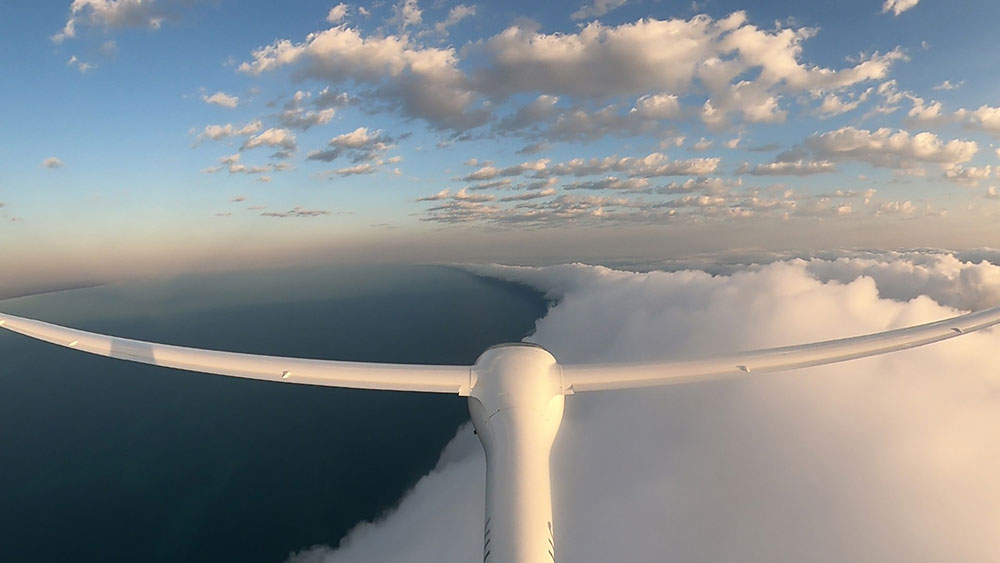

James Nugent, the new World Gliding Champion, Club Class, in the LS3 he flew to victory at WGC Narromine.
By Sean Young
After years of preparation, the 37th World Gliding Championships at Narromine finally got underway on 3 December 2023. Though the team at Narromine Gliding Club faced numerous challenges, they came through with a highly successful celebration of our sport. Deputy CD Beryl Hartley spent countless hours on the local organisation supported by a team of 54 volunteers including Arnie Hartley, Jenny Thompson as Operations Director Kerrie Claffey in charge of Marshalling, David Jansen on Tasking, and Competition Director Mike Durrant. I was honoured to be a small part of this great event.

The Opening Ceremony at Cale Oval Narromine. A shower passed by just before the ceremony making for a pleasantly cool evening.
The event included a heartfelt and gracious welcome to country from Ruth Carney, Elder of the Wiradjuri people. Gliding Australia Chairman Steve Peglar also gave a welcoming speech.
FAI Awards were also presented on the day. Beryl Hartley received the Paul Tissander Award from Grahame Hill the President of ASAC and Vice President FAI.
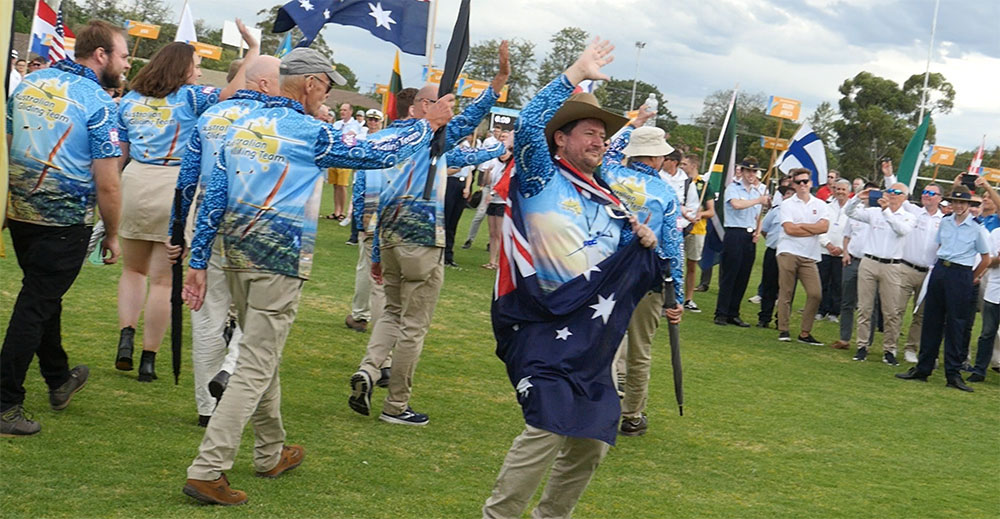
Great Start for Australia
Greg Beecroft started the contest brilliantly, winning Race 1 in Standard Class flying 501km at just under 129 kph. Bruce Taylor finished in 4th place. In 15m Class, Adam Woolley and Tobi Geiger started the competition well with Adam taking 2nd place and Tobi in 4th place in the first race. James Nugent came 3rd and Daniel Summers 7th in Club Class.
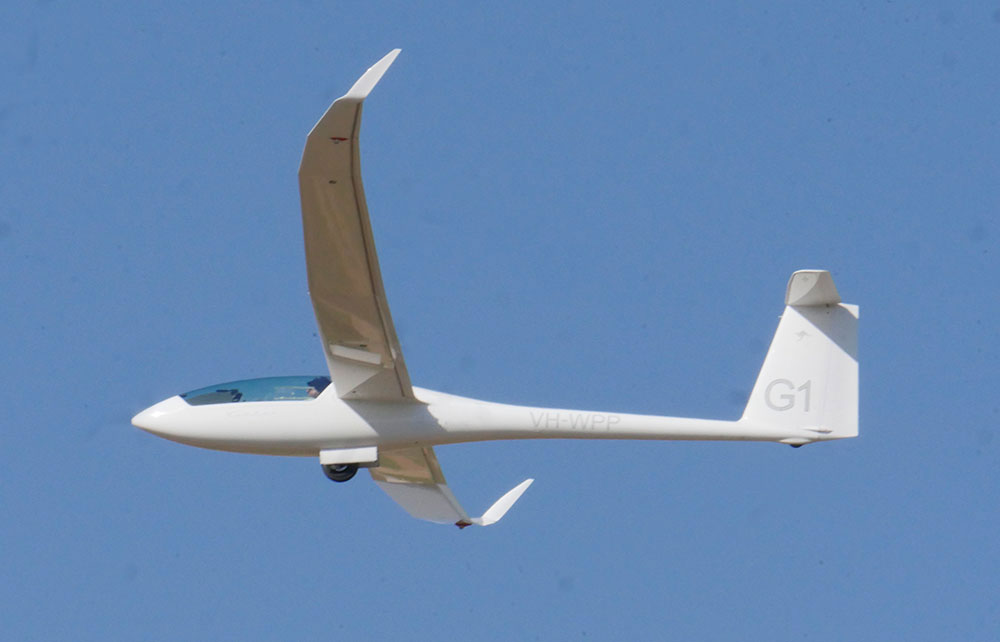
Adam Woolley in his Ventus 3 at Narromine. Adam finished in 7th place in 15m Class.
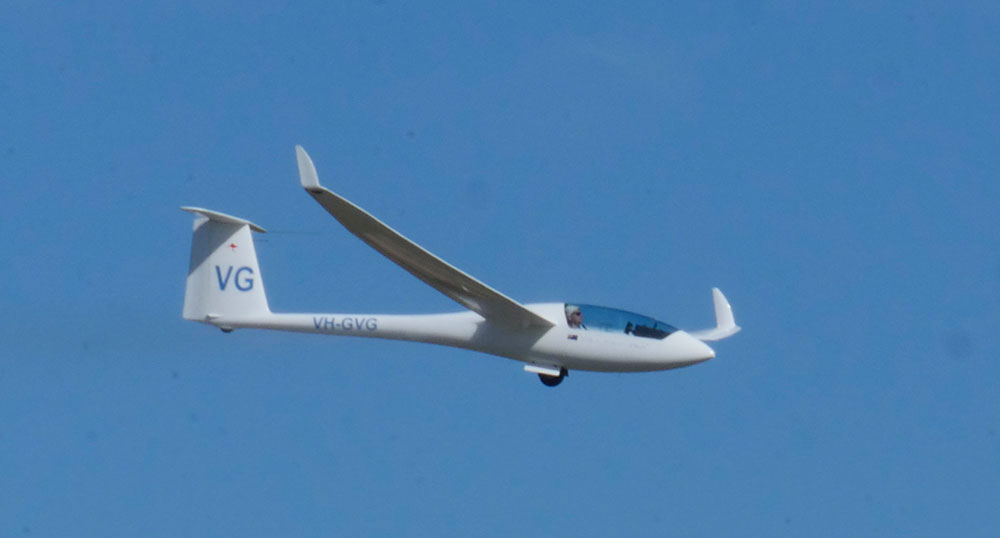
Tobi Geiger in his Ventus 2. Tobi finished in 10th place in 15m Class.
Race 2 – Blue with Strong Thermals
The sky was blue across the task area with some ephemeral cumulus, but still strong thermals of 6 – 10kt. The 15m Class was set a racing task of 437.47km. The task was completed more slowly than Race 1, with day winner Jan Pavlik, Czech Republic finishing the task at 112.97 kph. Yesterday's day winner Jeroen Verkuijl, Netherlands finished just .03 kph slower than Jan and was awarded joint 1st place. Erik Borgmann, Netherlands took 3rd place, with the current WGC 15m Class Champion Sebastian Kawa close behind in 4th place.
After two days of competition, the Netherlands duo Jeroen and Erik were in joint lead separated by just 4 points. Christophe Abadie, France was in 3rd place with Kawa in 4th place. The Dutch got off to a great start but, with Sebastian Kawa not far behind, as always, this contest was going to be won by the pilots who can maintain a consistent performance over many days and varying conditions.
In Standard Class, Race 1 winner Australian Greg Beecroft finished equal 12th with team mate Bruce Taylor. As a result he fell back to 7th position overall. Mac Ichikawa, who took 2nd place in Race 1, took 10th position nevertheless, putting him in top spot overall.
In Club Class, Hugo Corbille from France took 1st place, but Germany's Stefan Langer, day 1 winner and Uwe Wahlig, the current WGC Champion, maintained their 1st and 2nd place positions overall.
James Nugent came 7th but after his 3rd place in Race 1, he maintained his 3rd position overall. James needed to maintain his consistent performance to have a chance of a podium position.
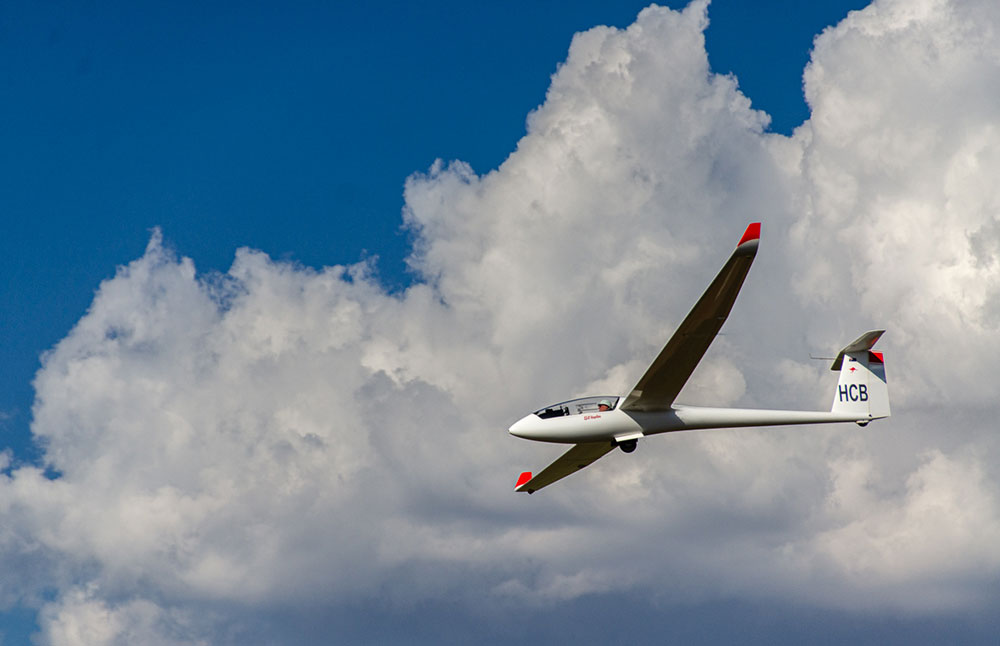
PHOTO: Jarek Mosiejewski

Gregory Beecroft won the Silver Medal in Standard Class. This was his first ever international competition. Congratulations to Greg on a terrific performance.
Race 3 – A Difficult Home Run
The forecast was for another blue day with a later start but better thermal heights than the day before. On track, the prediction was accurate until the final two legs where the three classes met up for the home run to Narromine.
Club Class was at the back of the grid today. This did not help them as on the penultimate leg, crossing the Macquarie Marshes north of Warren relatively late in the day, many gliders became stuck. Followers of the live tracking watched live as the heights of the gliders descended, while pilots struggled to climb in weak conditions, then landed out.
There was a scramble on Narromine Airfield as ground crews faced the prospect of hitching trailers and heading off into the wet paddocks to the north to retrieve their gliders in the fading evening light.
Hangar 7, the contest Outlanding Coordination Centre, was besieged by anxious crews wanting to get the exact location of their pilots and gliders. Calmly and professionally, Jack Hart and the team logged and processed land out information – well, sometimes he had to raise his voice to be heard over telephones with weak reception in far away paddocks. The Operations team, including Jenny Thompson and Jacob Bloom, diligently supplied the retrieve crews with information and options, including aerotows.
While the fortunate ones headed for the clubhouse for dinner and refreshments, crews picked up their trailers and headed off into the dusk. As the giant ball of the sun slipped into the vast Australian horizon, trailers streamed out of Narromine following their GPS and Google Maps.
Thankfully for most of the fleet of 79 gliders, although difficult, the day was strong enough for them to make it home to Narromine.
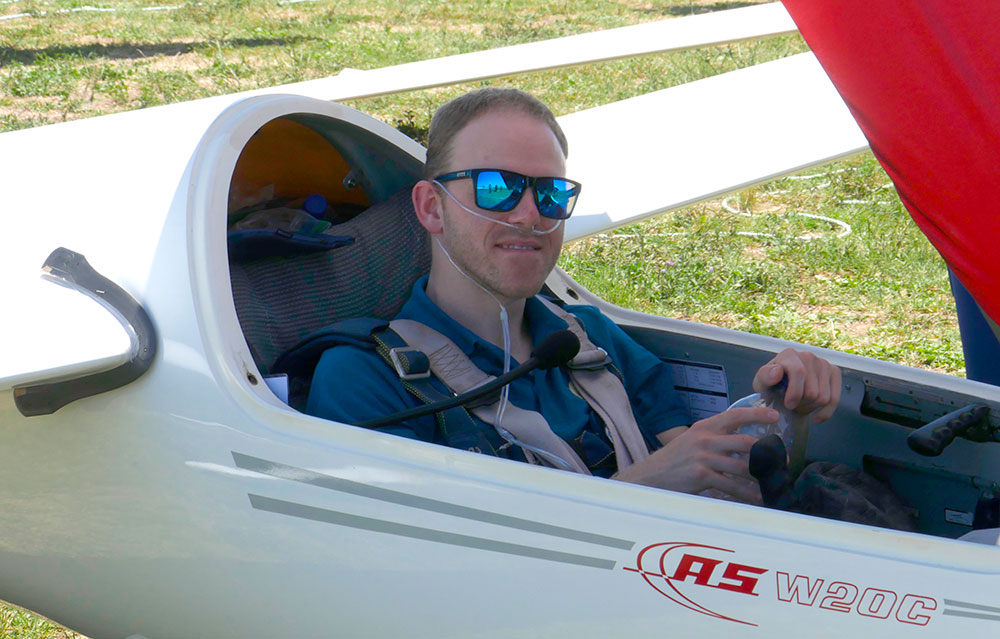
Daniel Summers flew his ASW 20C in Club Class finishing in 11th place
In Standard Class, Australian Bruce Taylor took 1st place, coming home well ahead of the rest of the Standard Class gliders. Perhaps this meant he started early, which may have been a wise decision. His team mate and Day 1 Winner Greg Beecroft was not far behind, finishing in 3rd place. Dutch pilot Sjaak Selen finished in 2nd place.
After three races and despite finishing 5th today, Makato Ichikawa, Japan retains his leading position with Sjaak Selen and Greg Beecroft not far behind. Not to be overlooked was consistent performer Tom Arscott, Great Britain who was just behind in 4th place overall.
In 15m Class, the Belgian team Andre Litt and Francois Delfosse had a great day, taking 1st and 2nd places. Steffen Goettler, Germany, came home in 3rd place. The Belgians finished the 421km course at 112kph. This is similar to the achieved speed yesterday despite the weaker conditions.
Overall, Christophe Abadie, France was in the lead, staving off the hungry Polish duo Sebastian Kawa and Lukasz Grabowski by just 4 points.
In Club Class, 12 of the fleet of 30 gliders landed without completing the 356km task. James Nugent came home 5th on the day and maintained his lead at the top of Club Class.
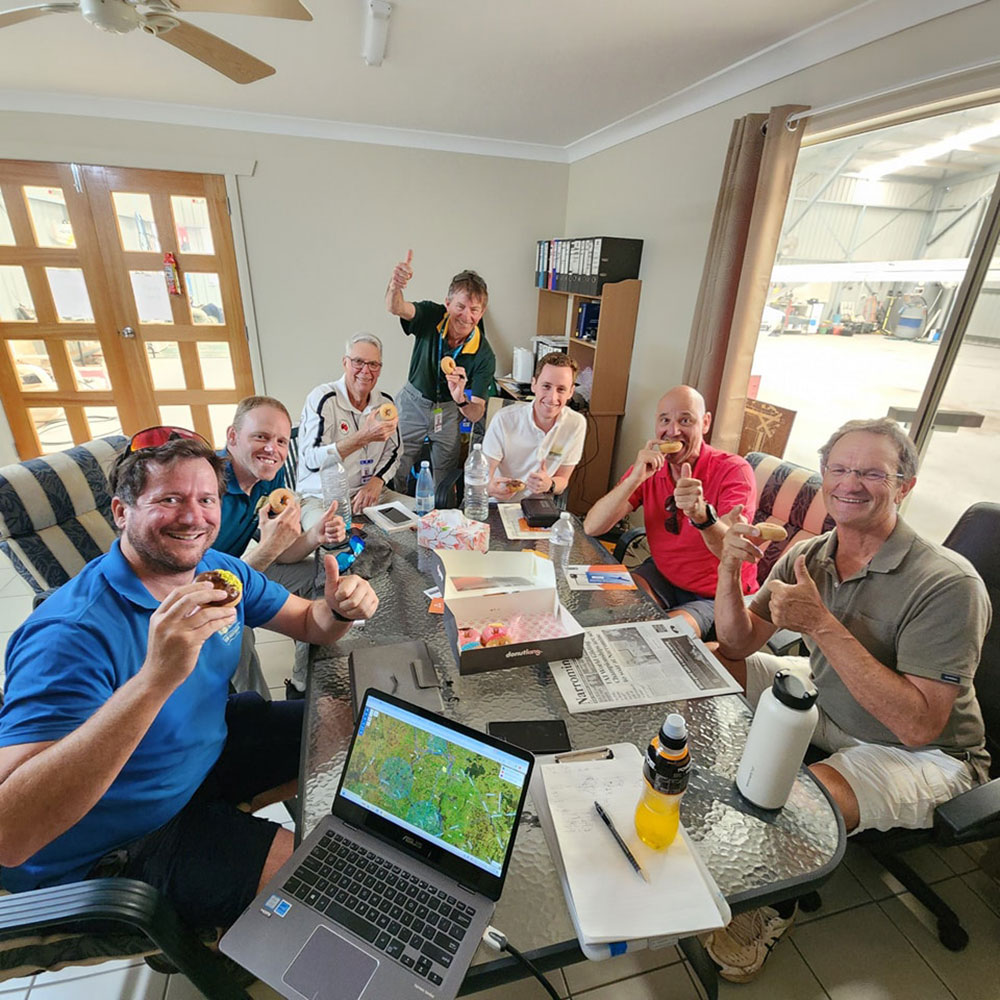
Team briefing fuelled with donuts.
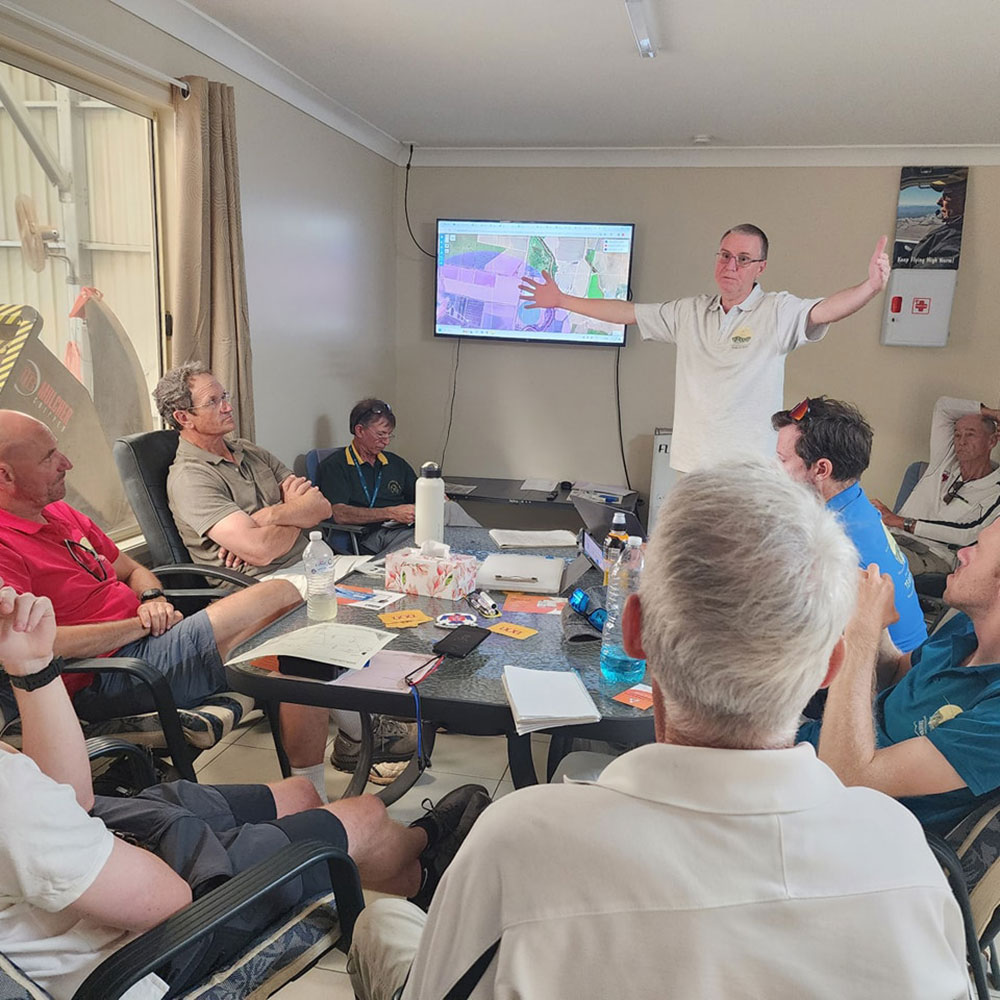
Team Coach Pete Temple describes the task.
Race 4 – Cyclone Jasper and an Inland Trough
The contest had got off to a good start but now the question was how many more races will there be? The weather conditions are forecast to be strong for the next few days but forced rest was looming on the horizon. Cyclone Jasper was forming in the Coral Sea and heading for North Queensland. There was also a deepening trough developing in inland Australia. If these two systems collided they had the potential to deliver a week of rain over the whole region.
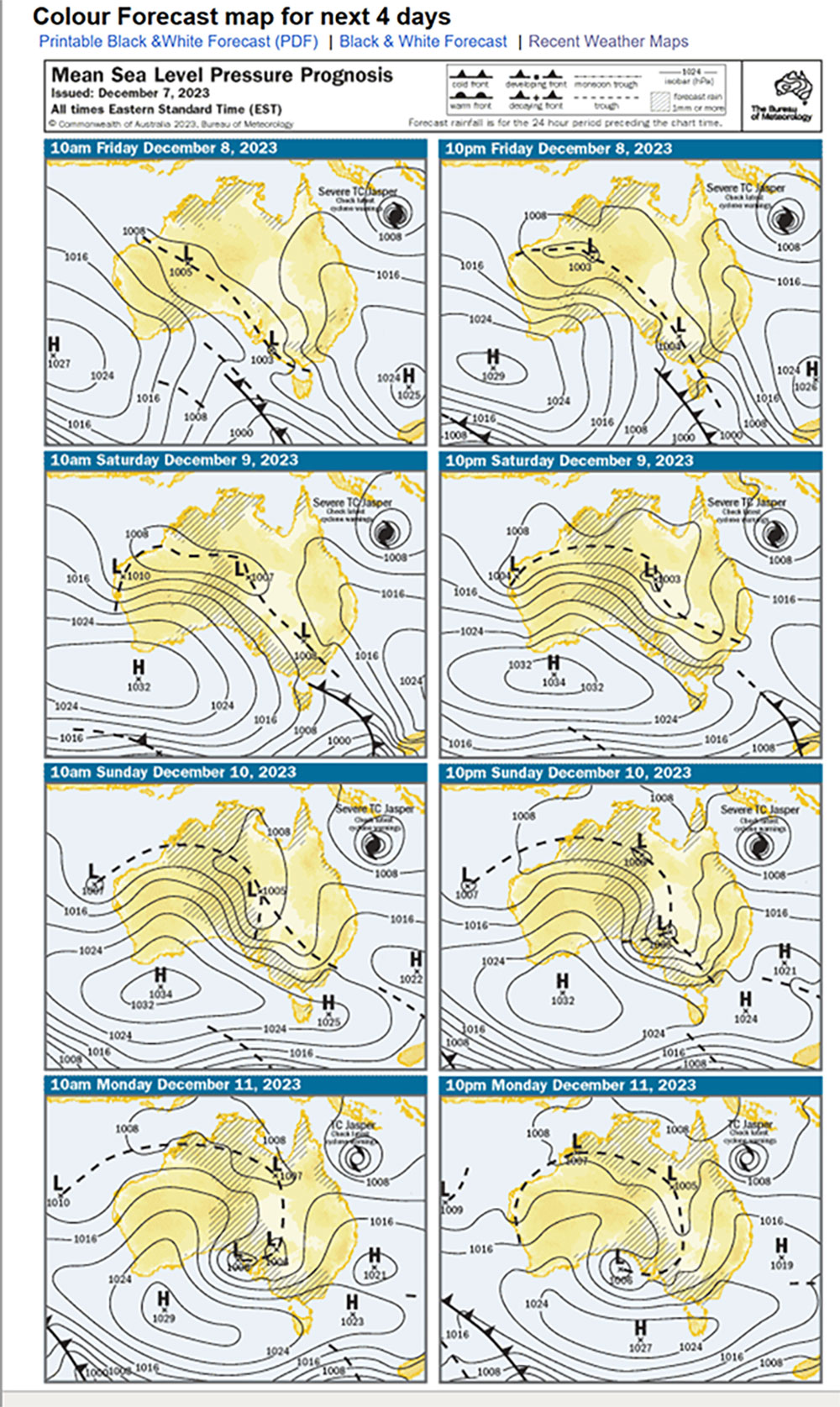
The BOM Four Day Forecast showing the predicted path of Cyclone Jasper which had the potential to funnel bad weather into the contest area.
James Nugent flew 412.98 km at 117.32 kph in an AAT task, taking 3rd place for the day in Club Class. The 932 points he earned were enough to keep him in the top position overall after Race 4.
Stefan Langer, Germany lost his joint top position with Nugent, but he was only 10 points behind him. James' teammate Daniel Summers was not far behind in 6th position with Club Class World Champion Uwe Wahlig in 5th place. With little more that 100 points between the top seven pilots and ten potential race days to go, the competition was far from decided.
In 15m Class Uys Jonker, South Africa won the racing task of 544.51km with a speed of 147.55 kph. Riccardo Brigliadori, Italy, was not far behind with a speed of 147.13 kph. Erik Borgmann, Netherlands came 3rd at 145.27 kph. Current 15m World Champion Sebastian Kawa, Poland was even faster at 149.25 kph. However, he incurred 50 penalty points for starting outside his PEV, putting him in 4th place.
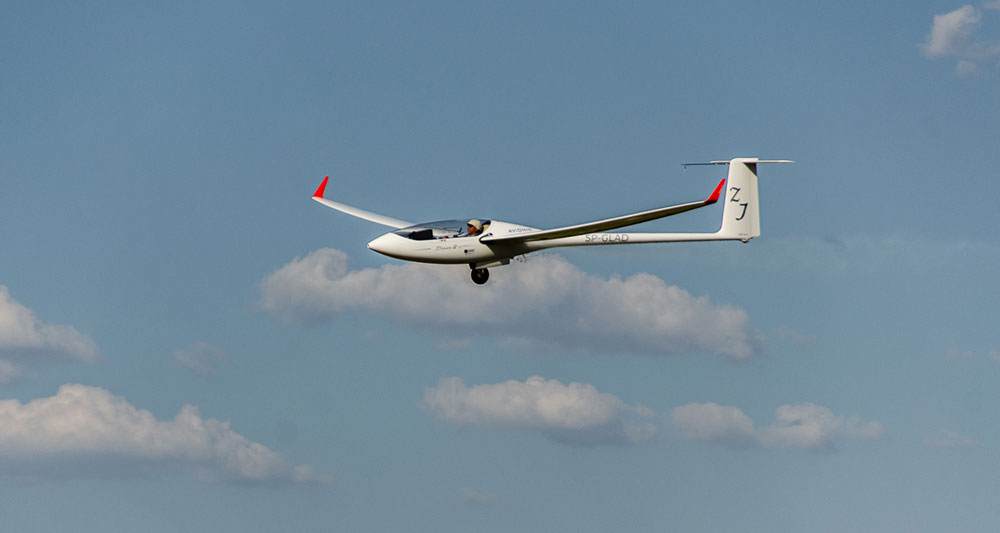
Sebastian Kawa, Poland, flew his Diana 2 to win the 15m Class Gold Medal. This was his 18th World Gliding Championship title and the 2nd time he has won 15m Class in Australia. PHOTO: Jarek Mosiejewski
The top ten pilots for the day all improved their overall positions including Adam Woolley and Tobi Geiger who were in contention at 12th and 13th places overall. Sebastian Kawa took over the lead by a thin 12 points.
The reigning World Champion in Standard Class, Simon Schröder, Germany, won the day flying the 422.21km racing task at a respectable speed of 128.40 kph. Philip Jonker, South Africa followed in 2nd place at 126.02 kph and Makoto Ichikawa took 3rd place at 122.86 kph.
Greg Beecroft and Bruce Taylor finished together at 119 kph to secure positions 7 and 8 and consolidate their position on the overall table.
Mak Ichikawa retained his top place overall ahead of Sjaak Selen, Netherlands with Beecroft holding 3rd, Tom Arscott, Great Britain 4th and Bruce Taylor 5th place.
Big Weather Day
For Race 4 the Narromine region put on a big weather day. As you can see from the speeds achieved on the racing tasks, days like these are basically excellent soaring days. But if you look at the results in Club Class where they flew an AAT task, you can see the wider story.
As the inland trough approached the Central West of NSW from the west, it pulled hot and humid air from the northern tropics, and soon the eastern tropical regions including the Coral Sea joined the mixed air mass as well. The meeting air masses were being forced into a tightening band producing conflicting winds, rapid convective uplift, clouds at levels above 10,000ft.
The clouds were forecast to reach an inversion top and spread out. More clouds were forecast towards the east over the ranges, with increasing cloud developing in the west.
It was not a uniform sky. The gliders on the racing tasks – that is, point-to-point all flying the same number of kilometres – had the easier day. The Club Class flying an AAT, where they had three circles of varying sizes that they had to fly into, either just touching the circle or flying well into them, meant they had to judge for themselves which route would make the best combination of distance and speed to win the day.
However, not only was it not a homogeneous sky, but there was also a clear wave influence above the thermals. This would have made conditions more difficult than they looked as the wave downdrafts 'crashed' the thermal tops, making the areas of good lift hard to find. This puzzled and frustrated some pilots as they found sinking air where they expected strong lift.
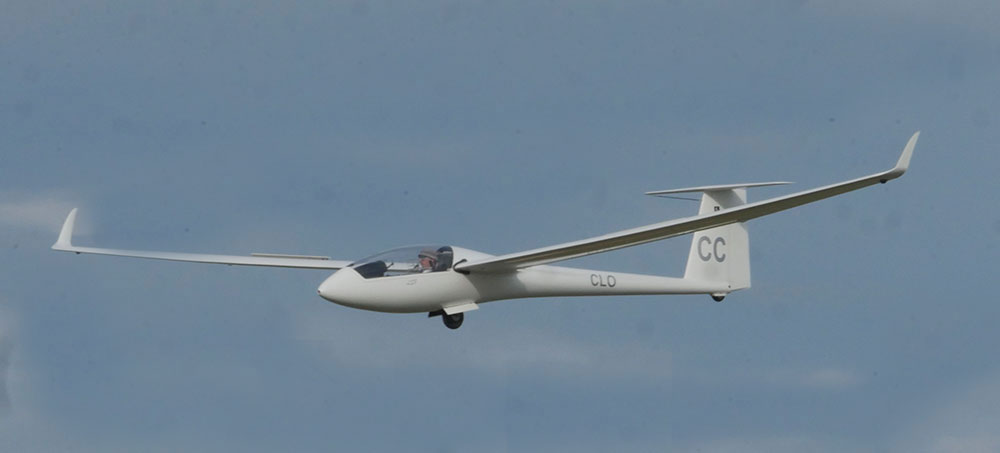
Tom Arscott, Great Britain in his LS8. Tom won the Standard Class title, his second World Championship win at Narromine. He also won Club Class at the Junior WGC at Narromine in 2015.
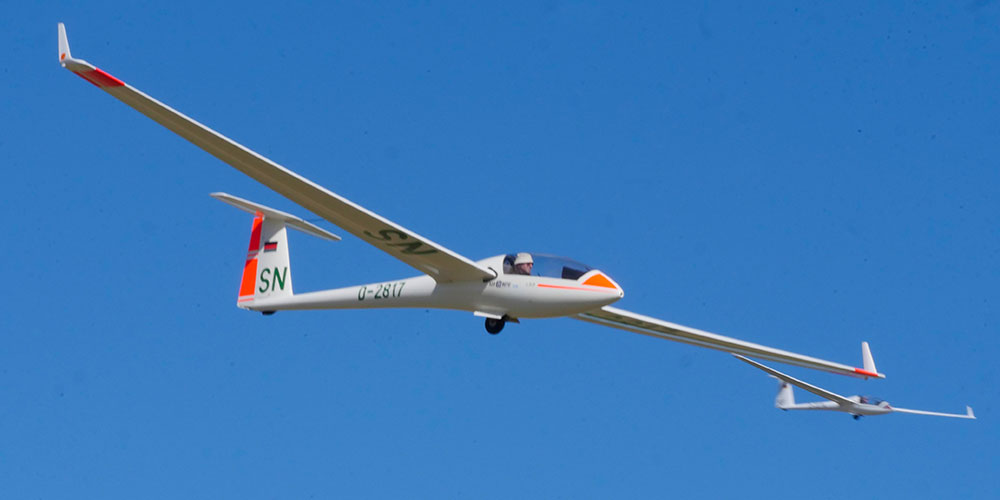
German pilot Uwe Wahlig flew an LS3 in Club Class, finishing in 2nd place overall.
Classic Narromine Setup
That night the weather deteriorated and the following day was a rest day. But looking at the four-day BOM weather chart, the next few days looked very strong to me.
Glider pilots all around the world spend their days sitting in their offices at home or at work checking the weather for the coming days to see if they should drop everything, kiss the girls goodbye and head out to the airfield. The question is, when should I drop everything and make the six-hour trip to Narromine?
The BOM four-day chart showed a large high pressure air mass off the coast of Western Australia and another high centred off the coast of Eastern Australia. Tropical cyclone Jasper was continuing to grow in the Coral Sea off the coast of northeastern tropical Queensland. However, the chart showed no low pressure area off the coast of northern Western Australia – in other words, the Pilbara Low.
This was significant, because when moist air from the Pilbara Low feeds into the trough depicted between the two high pressure systems, it can result in too much moisture in the trough, resulting in rain and washed out soaring conditions.
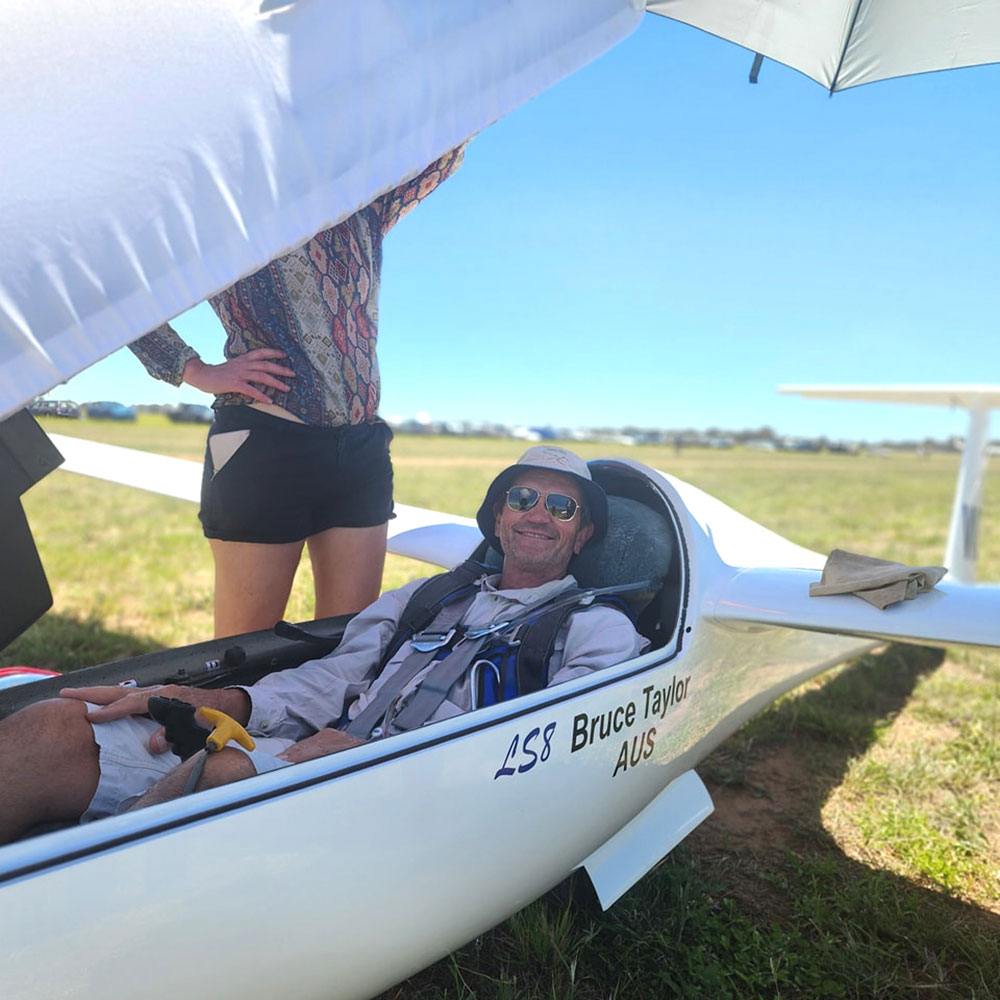
Bruce Taylor won Race 3 in Standard Class. During the contest he landed out twice, which cost him badly in the final placings
Race 5 - Unpredictable
It is the inland trough that produces the classic soaring conditions in Eastern Australia – that is, the pressure difference between the two high pressure systems, east and west. When the setup of the high pressures is just right, the low pressure line, or trough, between the two will have unstable air with high convection up to and above 13,000ft. It the air is too humid, then showers, often severe, will result. If the moisture is very low, then blue convection will occur. If the cooking pot is just right, there will be cumulus and the 'classic Narromine days' that we all wait for. Looking at this four-day chart, I would have been on my way to Narromine.
Oh, a note about Cyclone Jasper. Cyclones behave unpredictably. But according to the BOM chart, this 'friendly ghost' was not, as feared, going to feed a wet tropical stream of air into inland NSW – at least not for the next few days.
The weather forecast for the day predicted thermals up to 10,000 ft. However the trough to the west brought associated high cloud that covered the Narromine area, and cloud at varying levels was evident on satellite images. After briefing, several pilots asked me what I thought. 'Oh, it’ll burn off and be a great day,’ I said. Looking unconvinced, they dutifully prepared to launch at 12 noon as instructed.
Soon the launch time was pushed back to 12:30 and B tasks were set. This is not unusual at Narromine – is it unusual at any gliding site?
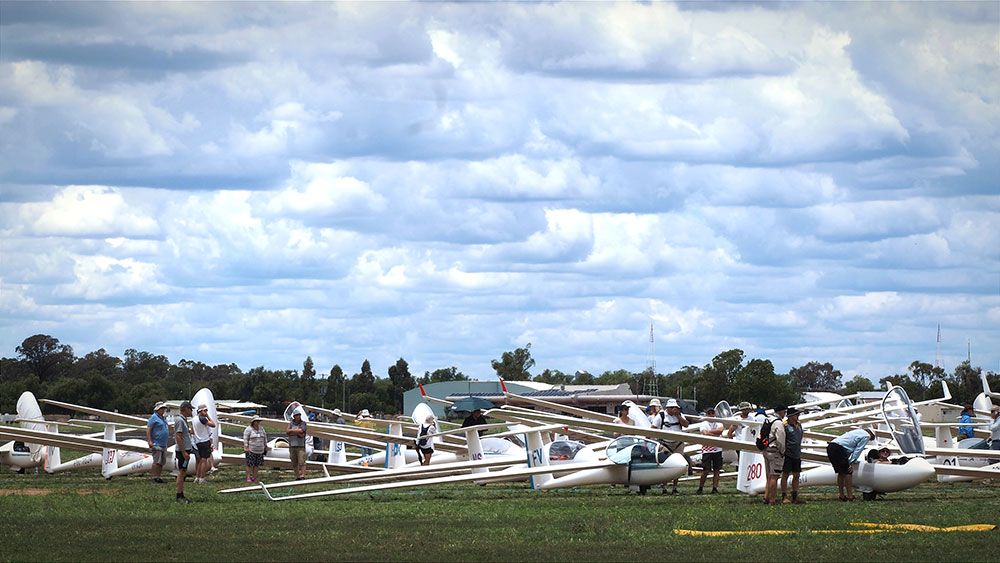
Narromine Airfield benefited from many improvements in the run up to the championships. The north south grass runway was widened, new access roads were put in, and hangars were built. Rain proir to the contest and during practice week kept the grass runways green and dust free for the 79 gliders and 10 tow planes. By the last day of the comp the conditions were dusty, but compared to other drier years the runways held up very well.
A Picture Speaks Many Words
The satellite image from the morning weather briefing was a caution to competing pilots. It showed a mush of cloud, high and low, slowly moving across New South Wales. High cloud covered Narromine for most of the day, while out in the task area it was nearly completely blue with low convection. It was not a great day.
The weather the pilots encountered out on track was very different from the forecast weather. The thermal tops were between 6 and 7,000 ft causing many pilots to struggle to climb above 4,000ft, particularly before the start.
Some pilots delayed starting in the hope of better conditions that did not arrive. Forced to set off before it was too late to complete the task, they struggled around the AAT tasks set for all three classes. However, nearly all pilots completed the course and made it back to Narromine, albeit with far slower speeds than on Race 4.
Slow Day
Tom Arscot, Great Britain won Standard Class flying 325.88km of the AAT Task at a speed of 106.55 kph to win a full 1,000 championship points. After this win, Tom was now in 1st place and Makoto Ichikawa was relegated to 4th place.
Australian Race 1 winner Greg Beecroft dropped to 5th place. Bruce Taylor landed out, succumbing to the weak conditions at the start time, and was now well down the rankings in 16th place. Uys Jonker, South Africa flew 335.16km at a speed of 110.58 kph to win his second day in a row in 15m Class, and Jacek Flis, Poland won the day in Club Class flying 332.61km at 99.44 kph. These AAT distances and speeds – from the best pilots in the world – indicate how tough the day was.
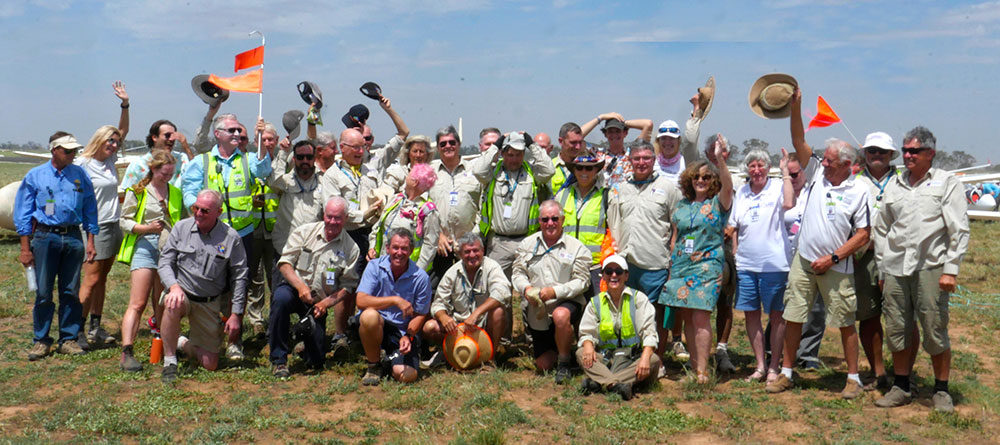
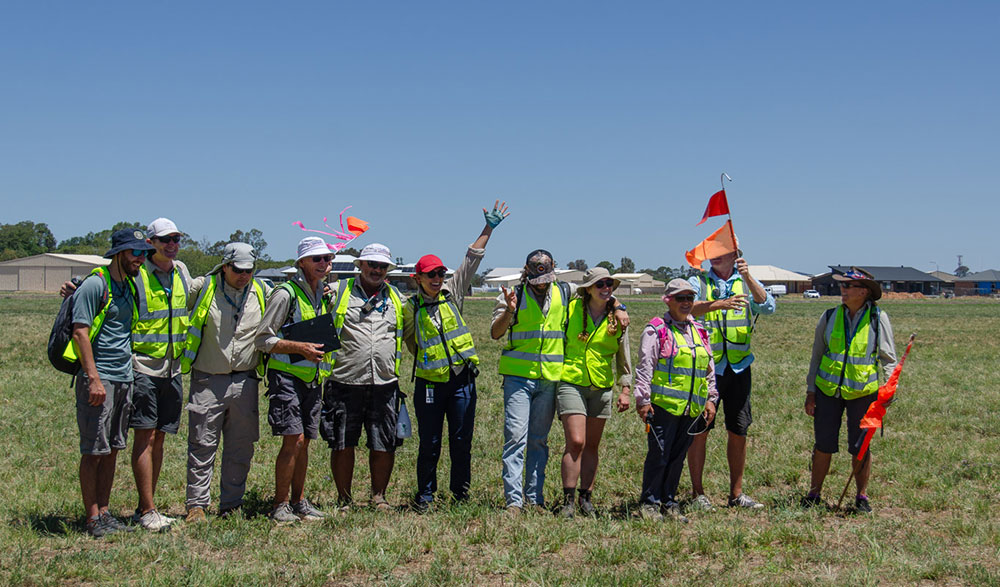
PHOTO: Jarek Mosiejewski
VOLUNTEERS
Fifty-four volunteers from around Australia worked tirelessly for many weeks to make WGC Narromine a success.
Championships Director Mike Durrant (centre kneeling) was joined by tug pilots, launch marshals, scrutineers, weatherman, task setter, scorer, office and IT support and others including the Safety Team.
Congratulations to the whole team for putting on a safe and extremely efficient operation. They did a superb job for Australia.
Race 6 – Strong Conditions
Although the soaring forecast at daily briefing was for a good soaring day, pilots and their teams were worried by the strong morning winds and uneasy about the overall weather situation. However, in the end, it was an excellent Narromine day with high cloud bases and strong thermal conditions over the entire task area.
Crossing the finish line at a blistering 151.54 kph, flying 546.93km, Adam Woolley won the day in 15m Class. He was closely followed across the finish line by his team mate Tobi Geiger, who finished the task at 151.38 kph.
The 15m and Standard Classes ended up with the strongest cumulus conditions with southern orientated tasks of over 550km. But even to the bluer north where the Club Class was sent on a 470.46km 'B Task', the conditions were strong with climbs above 10,000ft.
Standard Class also had a very fast day, won by Lukasz Blaszczyk, Poland who completed the 545.63km task at 151.71 kph.
The Club Class were set what was probably the most difficult task. The tasks for 15m and Standard Classes were mostly to the south, towards the inland trough with cumulus over a wide area. In contrast, Club Class were tasked to fly north into the predominantly blue area.
Nevertheless, the soaring conditions were strong with convection to well over 10,000ft. However some pilots flew from cloud base near Narromine at 10,000ft and more, straight towards the next turnpoint on the western edge of the Warumbungles nearly down to circuit height before finding a low, weak thermal to climb away in. James Nugent won his first day in Club Class.
The day was not all plain sailing and featured some early land outs. Some pilots were still getting to grips with the Australian conditions, such as the large distance between thermals on these high, convective days, for the top place getters.

A mixed cloudscape was typical of the conditions during the championships.
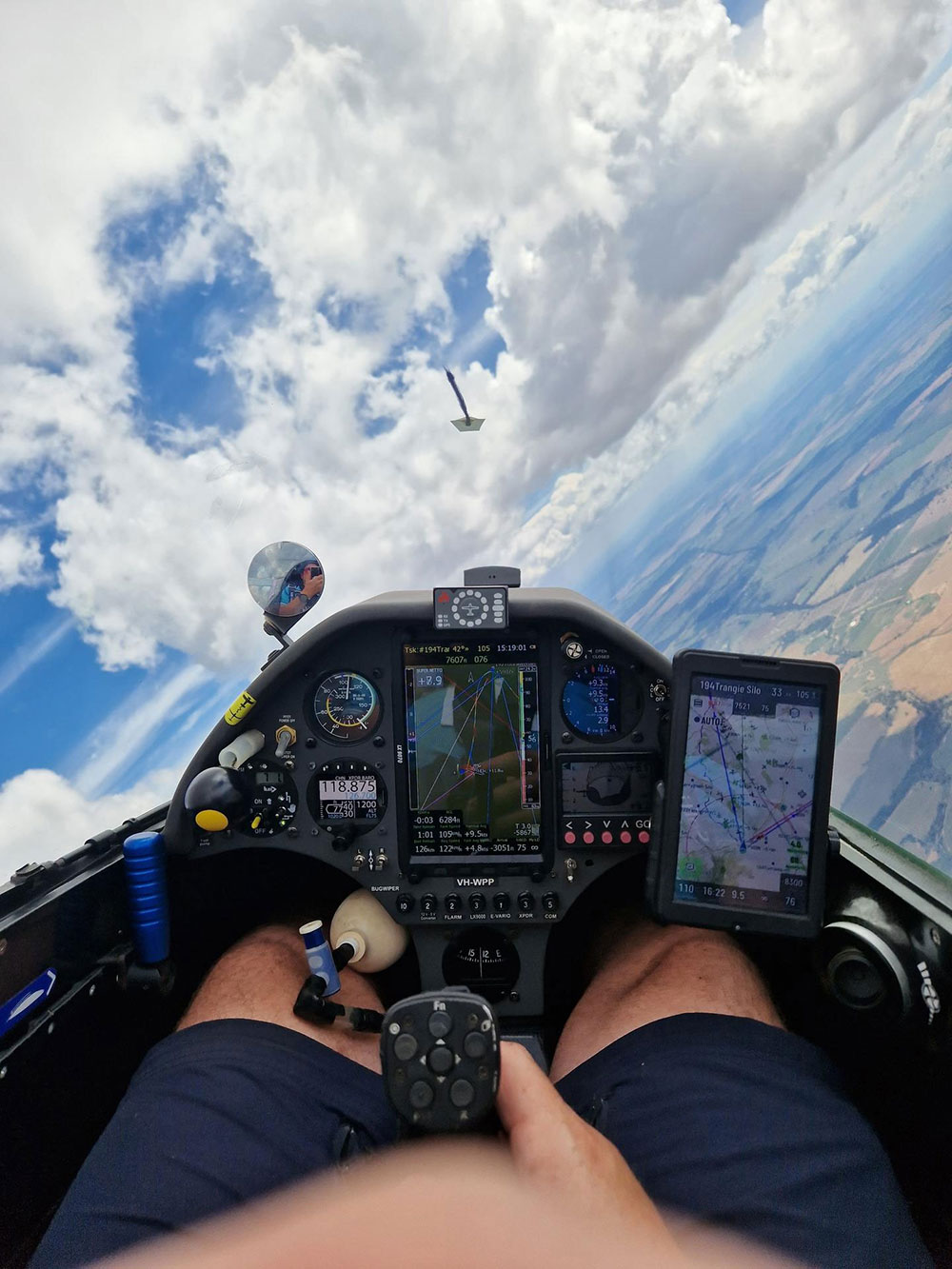
Race 7 – Nugent Wins Again
The next day James won his second day in Club Class, cementing his lead at the top of the table flying the 470.46km task at 114.37 kph. As always, consistency is the key to victory and Nugent was firmly in the lead after a sterling performance with a 110 point lead over reigning world champion Uwe Wahlig.
However, Monday 11 December was declared a no fly day, citing the ongoing heatwave and uncertain soaring window. The next day the area was enveloped in bushfire and the day was cancelled.
Race 8 – Shaking Up the Results
The trough moving towards the task area was predicted to produce a storm front in the late afternoon and evening. The three tasks were well set, sending the fleet to the north first, away from the front, then back towards the front and finally away from the front into a stiff northerly headwind.
It seemed counter intuitive to fly the final leg into a 20kt plus headwind, but the squall line was approaching from the south as the gliders made their turn in the final sector, enabling them to out-run the severe weather home.
The thermal conditions were predicted to be good with some cumulus. The day did indeed prove to be strong, but the tricky weather shook up the results, as should be expected in a World Championship.
In Club Class, Jacek Flis, Poland won his second day of the championships flying 363.65 km at 111.89 kph. James Nugent came 4th, leaving him in the lead overall by 198 points.
Lukasz Grabowski, Poland had his first day win in 15m Class. He flew the racing task distance of 381.34km at a speed of 136.83 kph. Adam Woolley did not have the best day and finished in 16th place. However, he retained his 5th place overall while Tobi Geiger moved up one place to 7th overall.
Sebastian Kawa was leading the 15m Class 40 points ahead of Uys Jonker who was followed by the stealthy German pair Henrik Bieler and Steffen Goettler. Neither of the German pilots had won a day but, like two peas in a pod, they had always been near the top of the table. Similar to the performance of the Germans in all three classes, they demonstrated the power of team flying and that a consistent high level of performance will result in a top of the table position.
In Standard Class, Tom Arscott came 14th just ahead of Greg Beecroft. Tom retained a comfortable lead overall with Greg still in 2nd position overall.
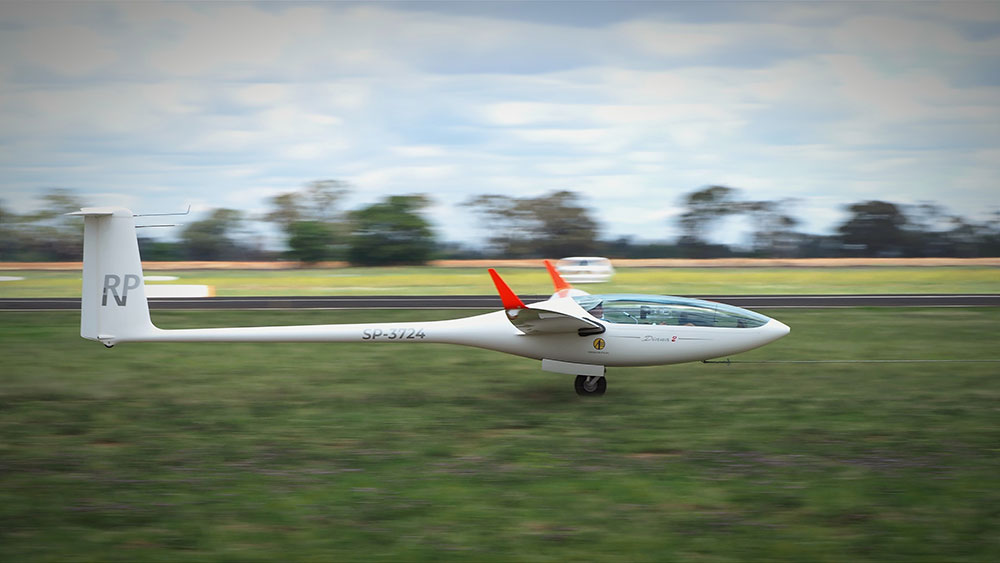
PHOTO: Stephan Raddi
Final Two Race Days – Changing Fortunes
The weather for the final two days looked good. The question was – would task setter David Jansen be content to set two more AATs? Or would he opt for more aggressive racing tasks?
The trough that produced the squall line passing through the task area the previous evening, was still visible to the east of Narromine in the morning. The air mass on the other (western) side of the trough felt decidedly different – and it was. Unstable air with thermals and cumulus were forecast. As to be expected with the passing of a trough, the wind changed direction and was brisk.
As well as the strong winds, up to 30kts at thermal top altitude, the ground in the task area was once again wet. Just how wet was determined by exactly where the squall line dumped water as it went through.
Several pilots, some champions and very experienced competitors, were caught out and landed in paddocks after only a few kilometres on track. However, for the pilots who were lucky enough, or good enough, the day was an opportunity to change their fortunes.
In 15m Class, Dutch duo Erik Borgmann and Jeroen Verkuijl, who had done so well early on in the contest, took the top two places flying the 375.32km racing task at 140.99 kph and 140.06 kph. Sebastian Kawa, Poland finished in 11th place but kept his lead overall.
Rasmus Ørskov, Denmark won his second day in Club Class flying 372.64km at 109.66 kph in the AAT. After 9 races, James Nugent was in 1st place 153 points ahead of German Uwe Wahlig with Stefan Langer in 3rd place overall.
With one more race day to go, the top three pilots looked secure in their positions. But with the possibility of landing out or other tactical failures, it was still all to play for.
Greg Beecroft, Australia finished 3rd in Standard Class, putting him in Silver Medal position in his first ever World Gliding Championship with just one more race to go.
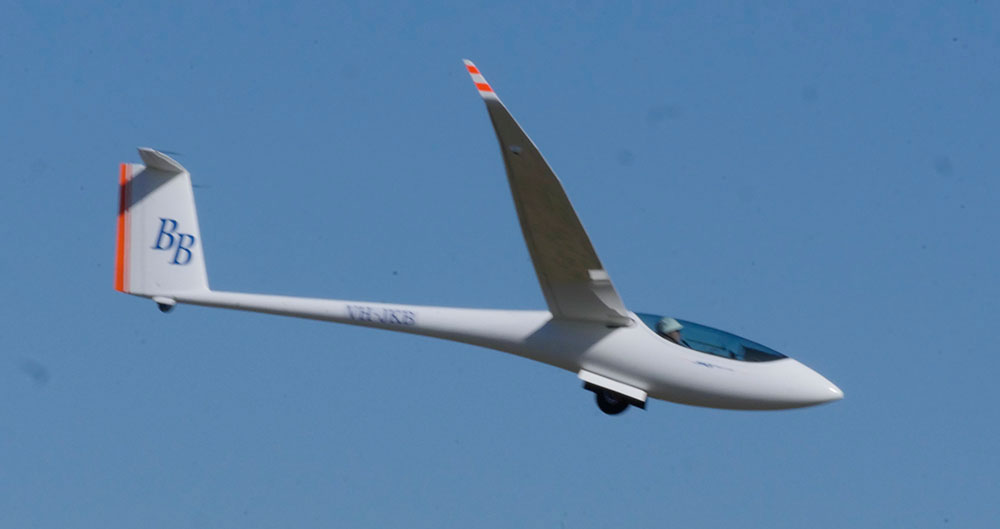
PHOTO: Jarek Mosiejewski
Final Day – Risks and Opportunities
The trough was to the east of Narromine on the final competition day. The air mass on the other (western) side of the trough was unstable but the ground and air were drying out. A few cumulus were forecast with good thermal conditions throughout the task area up to 10,000ft. The strong winds up to 30kts at thermal top altitude, which had been a feature of the previous day's race, were abating.
For the pilots who were still in contention for a podium place, the day was the last opportunity to change their fortunes. For those at the top of their class, this was a day to minimise risk, doing just enough to stay near the top for the day and maintain their leads.
Roelof Corporaal, Netherlands won the day in Club Class. James Nugent came home 2nd, which was far more than enough to secure his World Gliding Champion title. James dominated the Club Class in this contest. He never gave the impression that he would be a shooting star and fade as the days passed. Each day, he was at the top of the scoring table and won this championship emphatically, 211 points ahead of Uwe Wahlig.
Tom Arscott, who was already in a commanding lead at the top of the scoring table, came home in 3rd place winning the Standard Class WGC title in style.
Gregory Beecroft and Bruce Taylor finished 4th and 5th on the day in 15m Class. This was Greg Beecroft's first international competition and he secured a Silver Medal. Greg has been flying competitions in his home state of Western Australia and around the country for many years. It seems he has been hiding his talents from the rest of the world for all this time.
Sebastian Kawa finished in 12th place but this was still enough to secure the 15m World Championship title, the second one he has gained in Australia after winning at Benalla in 2017. This was Kawa's 18th WGC title, which is an incredible achievement.

WANT TO SEE MORE?
Videos - Stories - Photographs
To get the full picture of how the championships unfolded, you can watch videos including interviews with many of the daily winners, and other videos that were made during the competition. In addition, there are photographs and daily news stories.
WGC Narromine Website
wgc2023.com.au
Youtube
World Gliding
Championships Narromine
youtube.com/channel
Facebook
More information is available on the facebook.com
World Gliding Championships 2023
Team Cup
This championship produced the best team results for Australia in memory. Australia finished with Gold and Silver medals. Adam Woolley finished in 5th and Tobi Geiger in 7th places, which are excellent results and the best Australian result for many years. Daniel Summers finished in 11th place in Club Class also an excellent result. Bruce Taylor was set back by two land outs and finished in 18th position. This was enough to put Australia in 3rd place in the Team Cup behind Germany and Netherlands.
Though they missed out on a Championship Title, Germany nevertheless gave an outstanding performance winning Silver and Bronze medals in 15m and Club Classes and Silver and 4th place in Standard Class.
Australian Team Captain Miles Gore-Brown in interview noted the difficulties the team encountered in preparing for the championships during COVID, which disrupted the team selection and training process. The results at WGC Narromine are a great credit to Miles, Team Coach Peter Temple, the team crew and, of course, the six flying members of Team Australia.
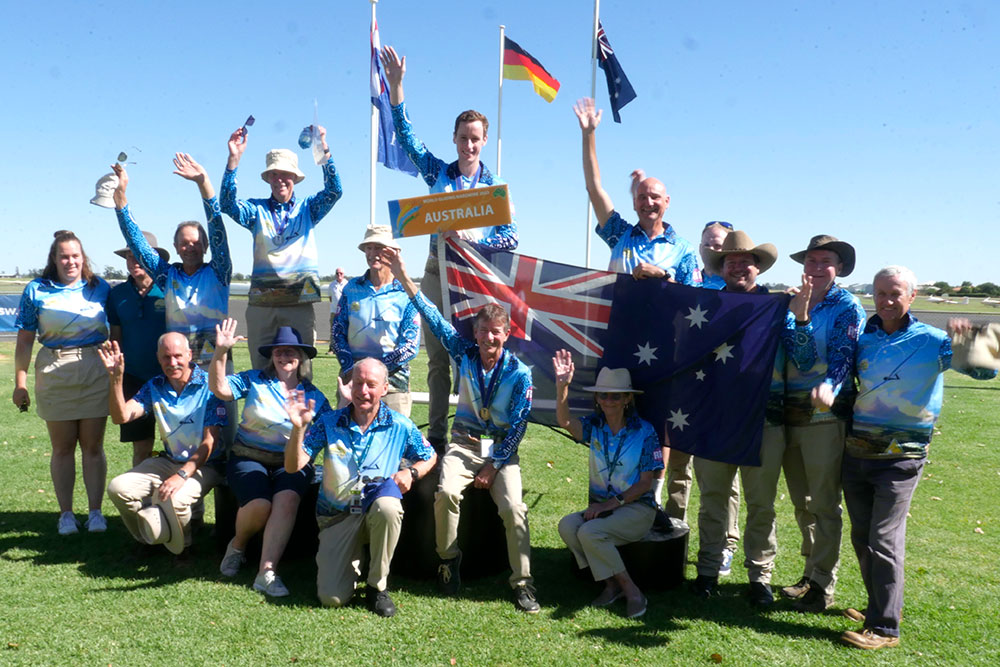
The Australian Gliding Team.

World Gliding Champion Club Class, James Nugent, Australia. Left, Silver Medalist Uwe Wahlig, Germany. Right, Bronze Medalist Stefan Langer, Germany.
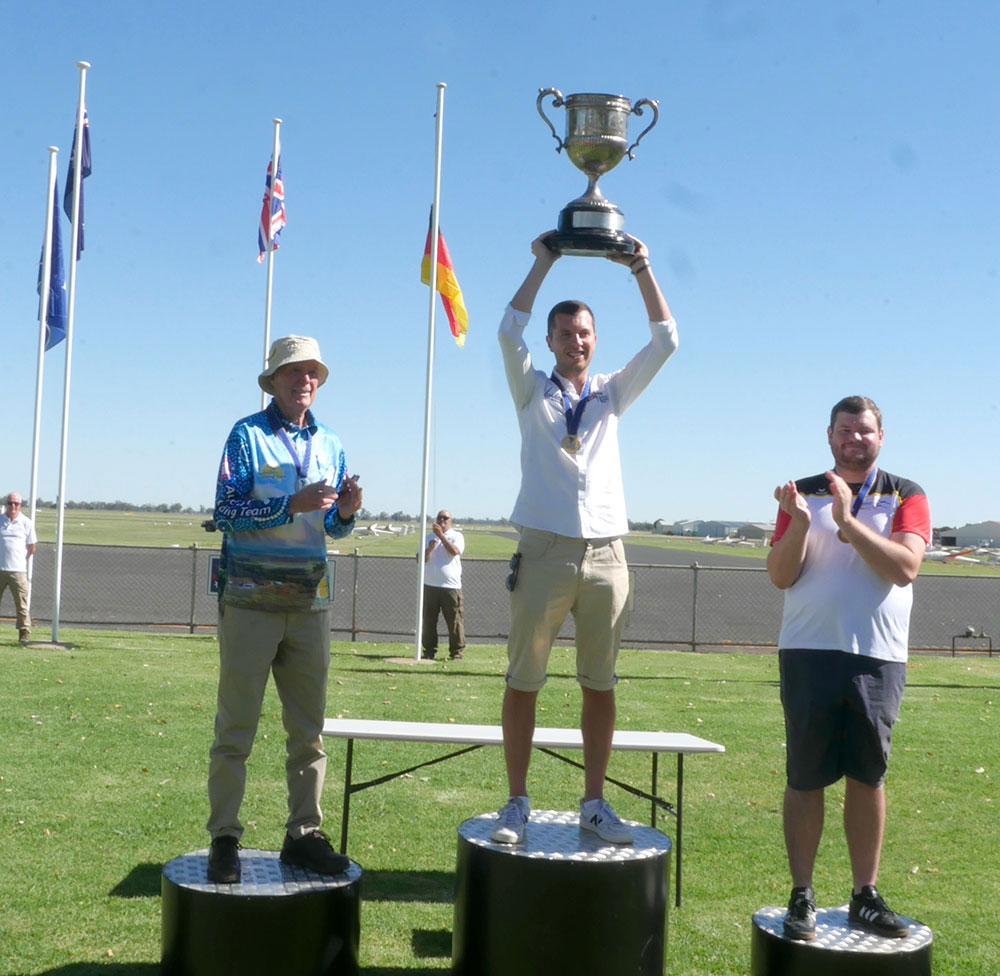
World Gliding Champion Standard Class, Tom Arscott, Great Britain. Left, Silver Medalist Gregory Beecroft, Australia. Right, Bronze Medalist Enrique Levin, Germany.
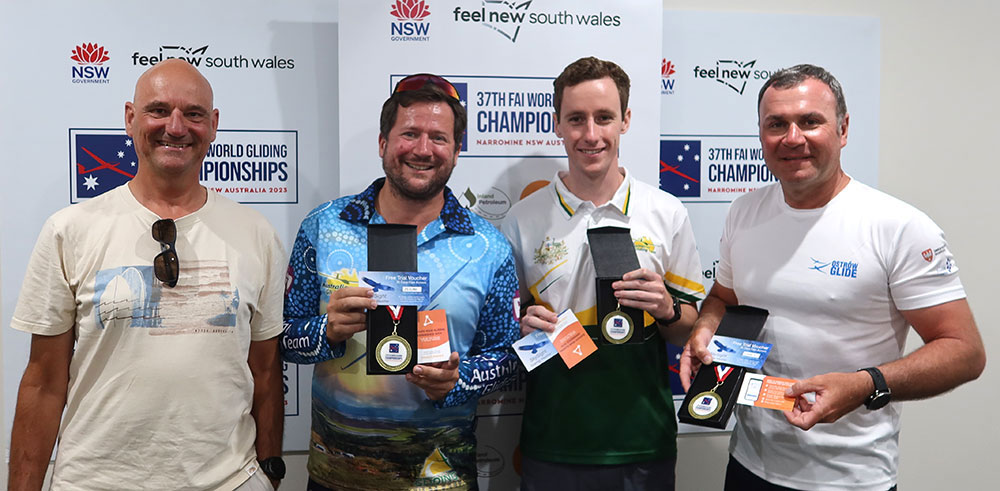
Race Six winners, from left: Tobi Geiger who came 2nd with team mate Adam Woolley who came 1st in 15m Class. James Nugent with his second day win in Club Class.Lukasz Blaszczyk, Poland winner in Standard Class.
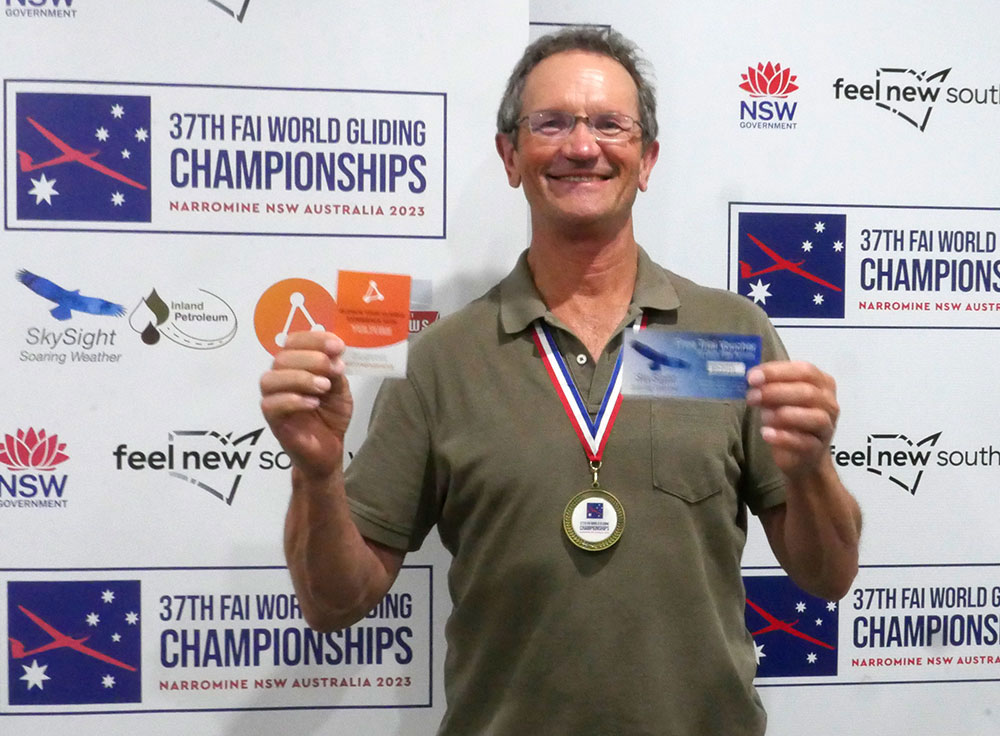
Bruce Taylor won Race 3 in Standard Class.
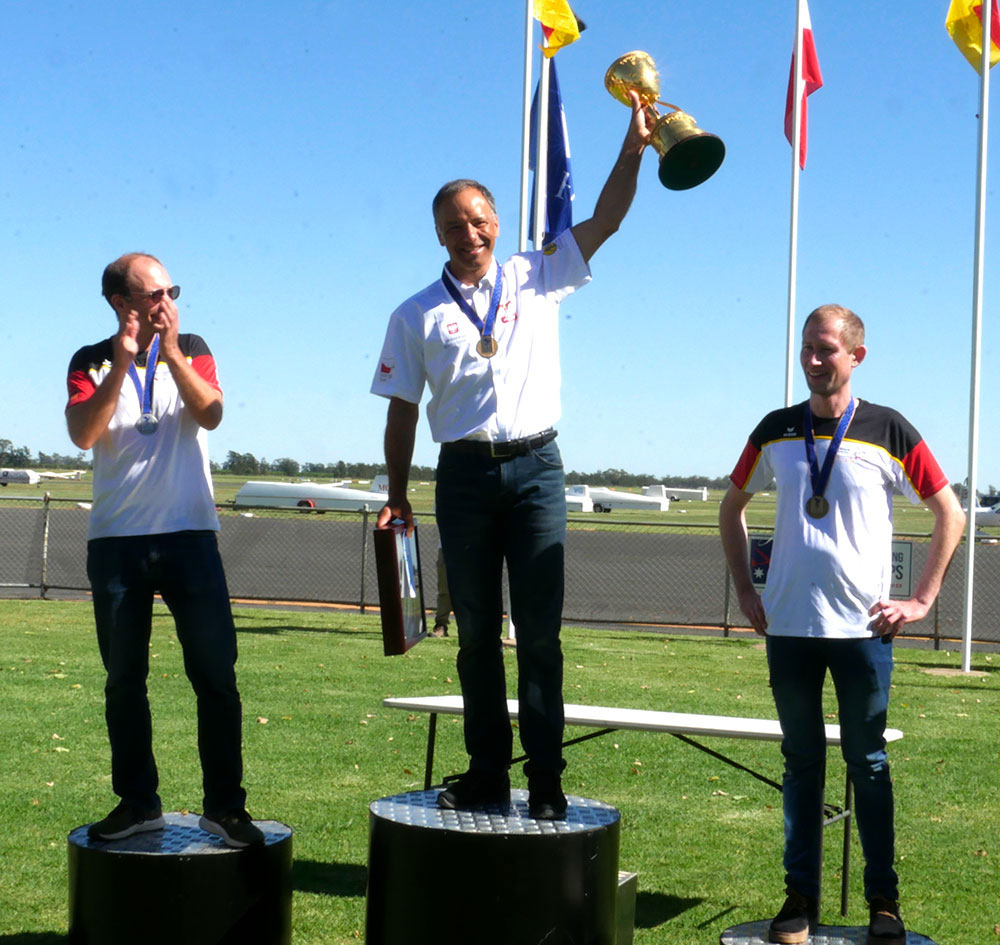
World Gliding Champion 15m Class, Sebastian Kawa, Poland. Left, Silver Medalist Henrik Bieler, Germany. Right, Bronze Medalist Steffen Goettler, Germany.

Team Cup Winners: Bernd Schmid for Germany 1st place. Left, Bart Renckens for Netherlands 2nd place. Right, Miles Gore-Brown for Australia 3rd place.































